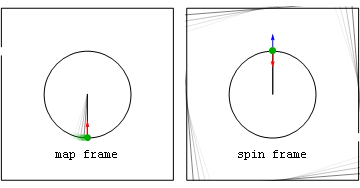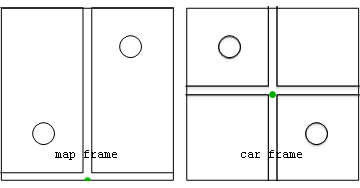The left hand side of this set of four equations (one each for the time-like and three spacelike values of index λ) is the object's proper-acceleration 3-vector combined with a null time component as seen from the vantage point of a reference or book-keeper coordinate system in which the object is at rest. The first term on the right hand side lists the rate at which the time-like (energy/mc) and space-like (momentum/m) components of the object's four-velocity U change, per unit time τ on traveler clocks.
Let's solve for that first term on the right since at low speeds its spacelike components represent the coordinate acceleration. More generally, when that first term goes to zero the object's coordinate acceleration goes to zero. This yields 
Thus, as exemplified with the first two animations above, coordinate acceleration goes to zero whenever proper-acceleration is exactly canceled by the connection (or geometric acceleration) term on the far right. [10] Caution: This term may be a sum of as many as sixteen separate velocity and position dependent terms, since the repeated indices μ and ν are by convention summed over all pairs of their four allowed values.
Four-vector derivations
The spacetime equations of this section allow one to address all deviations between proper and coordinate acceleration in a single calculation. For example, let's calculate the Christoffel symbols: [11]  for the far-coordinate Schwarzschild metric (c dτ)2 = (1−rs/r)(c dt)2 − (1/(1−rs/r))dr2 − r2 dθ2 − (r sin θ)2 dφ2, where rs is the Schwarzschild radius 2GM/c2. The resulting array of coefficients becomes:
for the far-coordinate Schwarzschild metric (c dτ)2 = (1−rs/r)(c dt)2 − (1/(1−rs/r))dr2 − r2 dθ2 − (r sin θ)2 dφ2, where rs is the Schwarzschild radius 2GM/c2. The resulting array of coefficients becomes: 
From this the shell-frame proper acceleration can be obtained by setting coordinate acceleration to zero and thus requiring that proper acceleration cancel the geometric acceleration of a stationary object i.e.  . This does not solve the problem yet, since Schwarzschild coordinates in curved spacetime are book-keeper coordinates [4] but not those of a local observer. The magnitude of the above proper acceleration 4-vector, to be found with the help of the metric tensor gij, is
. This does not solve the problem yet, since Schwarzschild coordinates in curved spacetime are book-keeper coordinates [4] but not those of a local observer. The magnitude of the above proper acceleration 4-vector, to be found with the help of the metric tensor gij, is  which is the upward frame-invariant proper acceleration needed to counteract the downward geometric acceleration felt by dwellers on the surface of a planet.
which is the upward frame-invariant proper acceleration needed to counteract the downward geometric acceleration felt by dwellers on the surface of a planet.
A special case of the above Christoffel symbol set is the flat-space spherical coordinate set obtained by setting rs or M above to zero: 
From this one can obtain, for example, the centripetal proper acceleration needed to cancel the centrifugal geometric acceleration of an object moving at constant angular velocity ω = dφ/dτ at the equator where θ = π/2. Forming the same 4-vector sum as above for the case of dθ/dτ and dr/dτ zero yields nothing more than the classical acceleration for rotational motion given above, i.e.  so that ao = ω2r. Coriolis effects also reside in these connection coefficients, and similarly arise from coordinate-frame geometry alone.
so that ao = ω2r. Coriolis effects also reside in these connection coefficients, and similarly arise from coordinate-frame geometry alone.




























